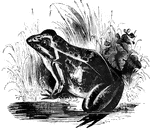Clipart tagged: ‘batrachia’
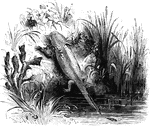
Axolotl
"Ten to fiteen inches long, of a brownish or grayish color, spotted with black. On each side of the…
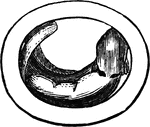
Embryo
"Figure 1 represents the embryo as it appears several days after the egg is deposited." — Goodrich.…

Form of the embryo
"Figure 2 gives an outline of its form; the arrows at the side of the head show the currents of water…
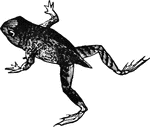
Frog with tail
Nearing the end of its development, a gradually shrinking tail is all that remains of the tadpole.
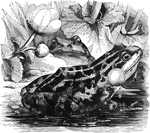
Edible frog
"It is rather larger than the common frog, and its nocturnal croakings are so loud and disagreeable,…
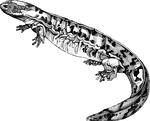
Alleghany hell-bender
"It is one to two feet long, dark slate color, feeds on worms, crawfish, fishes, and aquatic reptiles.…

Siren lacretina
"Two feet long, black above and dusky beneath. It is of an eel-like form, lives in the muddy water of…
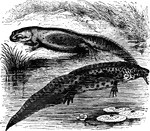
Smooth newt
"It is three and a half inches long, the skin smooth as a frog's; it lives in ponds and ditches, and…

Violet-colored salamander
"Is five to seven inches long,; blueish-black, with bright yellow spots; habits nocturnal, living under…
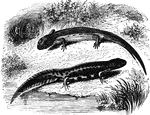
Salamanders
"The Land Salamanders, unlike the Tritons, are ovo-viparous, though the young at first inhabit the water…
Newly hatched tadpole
"Figure 5 shows the form of the tadpole when first hatched, which usually takes place about four weeks…
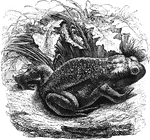
Common European toad
"It is a harmless animal, though its ungainly appearance has made it the subject of general aversion."…
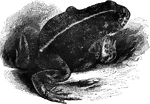
Natter-jack toad
"Resembles the common toad of Europe in appearance: there are also other foreign species, among which…
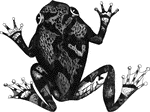
Squirrel Tree-toad
"Is of a brownish or light ash-color, and is found under logs and the bark of decayed trees." — Goodrich,…

Surinam toad
"At the breeding season the back of the female exhbits a number of small pits; into these pits the male…
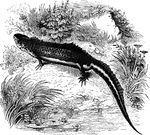
Common warty-newt
The common warty-newt of Europe... is six inches long, and is common in large ponds and ditches, where…

